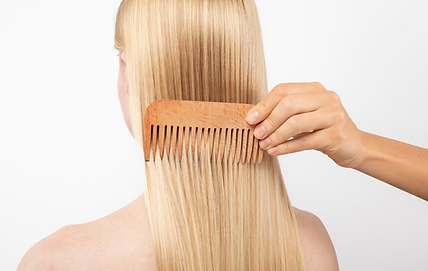DANDRUFF
Flaking scalp can be the consequence of immune system and microbiome problems and microflora activity

HOW TO IDENTIFY THE TYPE OF DANDRUFF: DRY OR GREASY?
SIGNS OF DRY DANDRUFF:
-
Small white flakes that easily fall onto clothing;
-
Itching and a feeling of tightness on the scalp;
-
Appears even with infrequent washing, and worsens in cold weather;
-
The hair looks dull and brittle.
SIGNS OF GREASY DANDRUFF:
-
Large yellowish flakes that stick to the skin and hair;
-
Oily shine at the roots, even after washing;
-
Inflammation and redness on the scalp;
-
Often accompanied by an unpleasant odor.
THERE ARE MULTIPLE REASON FOR DANDRUFF:
WRONG PRODUCTS
Aggressive shampoos, infrequent washing, or excessive use of styling products disrupt the balance of the scalp

OVERDRIED SCALP
Ultraviolet light, sun exposure, coloring, blow-drying, hard or chlorinated water, or inappropriate hair care cause stress and dryness of the scalp

GI TRACT PROBLEMS
Intestinal problems impair the absorption of zinc and B vitamins, which are key elements for scalp health

STRESS
Hormonal imbalances, vitamin deficiencies (especially lack of zinc and B vitamins)

DANDRUFF PRODUCTS
SEBORRHEIC DERMATITIS
Inflammatory scalp condition, accompanied with itchiness, redness and flaking

HOW TO IDENTIFY SEBORRHEIC DERMATITIS?
-
Persistent itching and irritation of the scalp
-
Redness and inflamed areas
-
Formation of yellow or white flakes (depending on the type)
-
A feeling of tightness or burning
THERE ARE MULTIPLE REASONS FOR SEBORRHEIC DERMATITIS:
HORMONAL CHANGES
Changes in estrogen, androgen, or thyroid hormone levels directly affect oil production and scalp regeneration.

FAMILY HISTORY
Genetic skin predisposition to autoimmune reactions increases the risk of dermatitis

DECREASED IMMUNITY
Weakened immune system triggers the activity of pathogenic skin microflora, making the inflammation stronger

STRESS
High cortisol levels disrupt oil gland function and reduce the skin’s immunity

SEBORRHEIC DERMATITIS PRODUCTS
PSORIASIS
A chronic inflammatory disease. In severe cases manifests as red, scaly plaques under the hair, significantly reducing quality of life

HOW TO IDENTIFY PSORIASIS?
-
Dense red patches with silvery scales, especially along the hairline, behind the ears, and on the back of the head
-
Severe itching and burning, which intensify when scratched
-
Bleeding when the scales are removed (Auspitz sign)
-
Hair in the affected area does not fall out, but may stick together at the roots due to plaques
THERE ARE MULTIPLE REASONS FOR PSORIASIS:
FAMILY HISTORY
If the parents had psoriasis, the risk increases by 30-50%

IMMUNE SYSTEM MALFUNCTION
T-lymphocytes mistakenly attack skin cells, accelerating their division by 5-10 times

STRESS AND DAMAGED SKIN
Even minor scratches can trigger new plaques (Koebner phenomenon)

HORMONAL CHANGES
Flare-ups often occur during pregnancy, menopause, or endocrine disorders

PSORIASIS PRODUCTS
SCALP & HAIR CARE PRINCIPLES
REGULARITY
A course of procedures helps cleanse the scalp from dandruff, excess oils, as well as restore scalp immunity



















